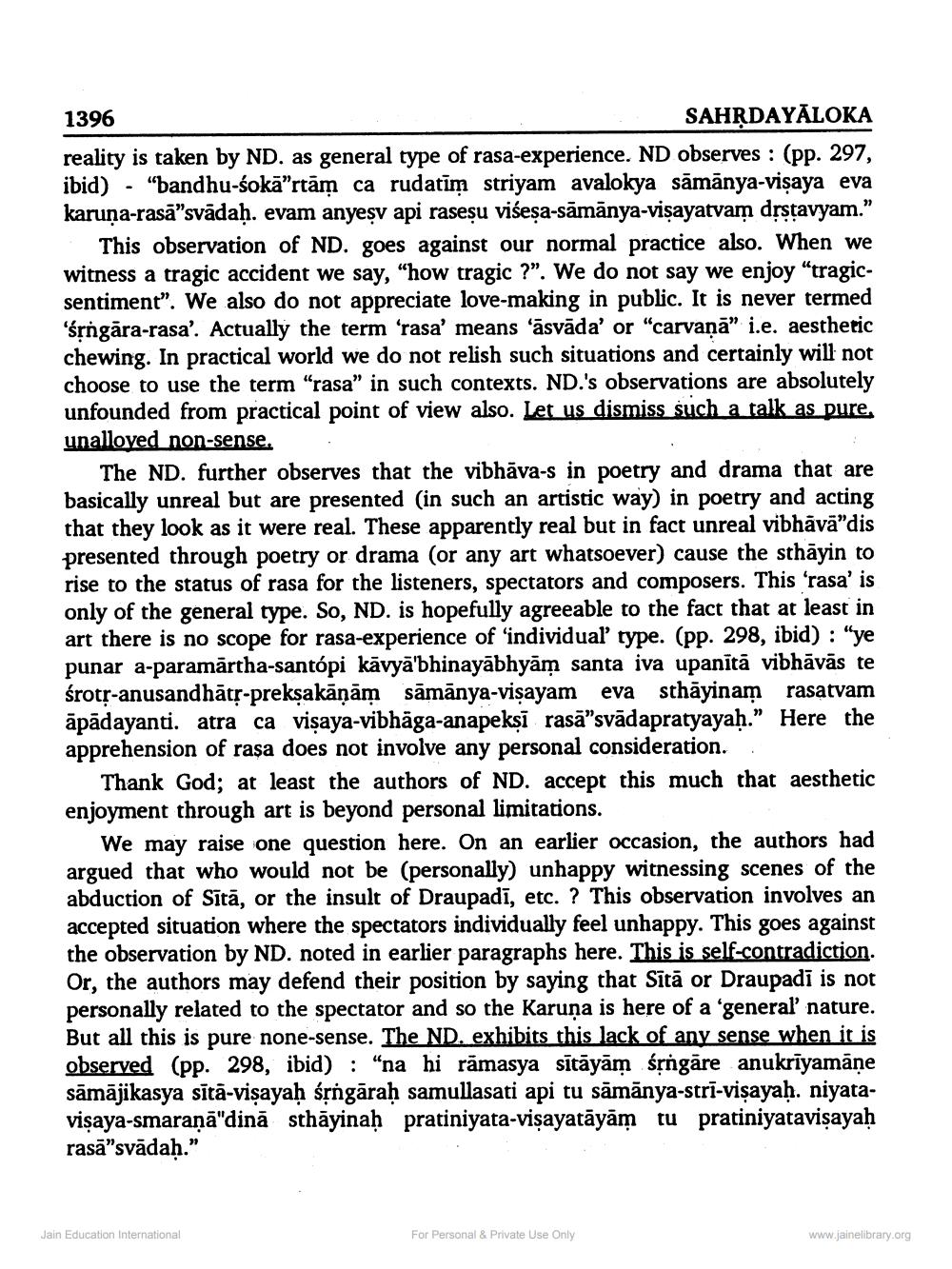________________
1396
SAHĶDAYĀLOKA reality is taken by ND. as general type of rasa-experience. ND observes : (pp. 297, ibid) - "bandhu-sokā"rtām ca rudatīm striyam avalokya sāmānya-visaya eva karuņa-rasā"svādaḥ. evam anyeşv api raseșu višeșa-sāmānya-visayatvam dostavyam.”
This observation of ND. goes against our normal practice also. When we witness a tragic accident we say, "how tragic ?". We do not say we enjoy "tragicsentiment". We also do not appreciate love-making in public. It is never termed 'śrógāra-rasa'. Actually the term 'rasa' means 'āsvāda' or "carvanā" i.e. aesthetic chewing. In practical world we do not relish such situations and certainly will not choose to use the term "rasa” in such contexts. ND.'s observations are absolutely unfounded from practical point of view also. Let us dismiss such a talk as pure, unalloved non-sense. .
The ND. further observes that the vibhāva-s in poetry and drama that are basically unreal but are presented in such an artistic way) in poetry and acting that they look as it were real. These apparently real but in fact unreal vibhāvā"dis
rough poetry or drama (or any art whatsoever) cause the sthāyin to rise to the status of rasa for the listeners, spectators and composers. This 'rasa' is only of the general type. So, ND. is hopefully agreeable to the fact that at least in art there is no scope for rasa-experience of individual type. (pp. 298, ibid) : "ye punar a-paramārtha-santópi kāvyā'bhinayābhyām santa iva upanītā vibhāvās te śrotr-anusandhātr-preksakāņām sāmānya-visayam eva sthāyinam rasatvam āpādayanti. atra ca visaya-vibhāga-anapekşi rasā"svādapratyayaḥ.” Here the apprehension of rașa does not involve any personal consideration.
Thank God; at least the authors of ND. accept this much that aesthetic enjoyment through art is beyond personal limitations.
We may raise one question here. On an earlier occasion, the authors had argued that who would not be (personally) unhappy witnessing scenes of the abduction of Sītā, or the insult of Draupadī, etc.? This observation involves an accepted situation where the spectators individually feel unhappy. This goes against the observation by ND. noted in earlier paragraphs here. This is self-contradiction. Or, the authors may defend their position by saying that Sītā or Draupadi is not personally related to the spectator and so the Karuņa is here of a 'general nature. But all this is pure none-sense. The ND. exhibits this lack of any sense when it is observed (pp. 298, ibid) : “na hi rāmasya sītāyām śộngare anukriyamāne sāmājikasya sītā-visayaḥ śộngāraḥ samullasati api tu sāmānya-strī-visayaḥ. niyatavisaya-smaraņā"dinā sthāyinaḥ pratiniyata-visayatāyām tu pratiniyatavisayah rasā"svādah."
Jain Education International
For Personal & Private Use Only
www.jainelibrary.org




